It’s always a bit sad, isn’t it?
The arrival of shorter days and cooler nights as summer winds down seems to create a little twinge of nostalgia for those long days of fun in the sun. But, autumn’s such a spectacular season, it doesn’t take much to get excited about the changing of the gourd. Er, guard.

One of the most anticipated highlights of fall is the cornucopia of wonderfully colored fruit and vegetables that become available for our cooking adventures.
And among the most notable of those fruits and veggies are the many varieties of winter squash. Sweet tasting with brightly colored, unique shapes, they’re a welcome addition to numerous dishes, from hearty stews and soups to pies and cheesecake.
Winter squash are the hard-skinned cousins of the summer varieties and include common members such as butternut, Hubbard, acorn, spaghetti, and pumpkin.
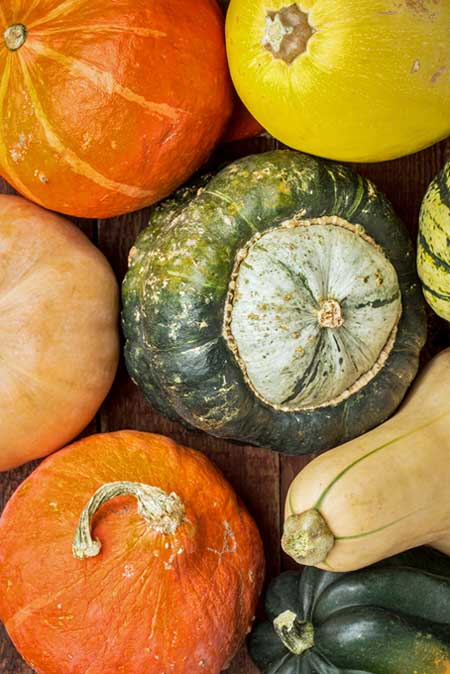
Known for their nutritional value, winter squash offers high levels of important anti-inflammatory vitamins, minerals, and antioxidants that help to support a strong immune system, and several other health benefits as well.
So, let’s have a closer look at some of those health benefits, and how to select, cook, and store winter squash. After that, you’ll find a couple of tasty recipes to enjoy these bright lights of autumn.
Winter Squash?
The term “winter squash” is actually a bit misleading. While crops of these fruits are harvested in the fall, they get their name from their ability to be stored throughout the cold winter months.
Their thick, hard shells allow them to be kept for up to six months, if provided with optimal conditions and stored in a cool, dry spot out of direct sunlight.
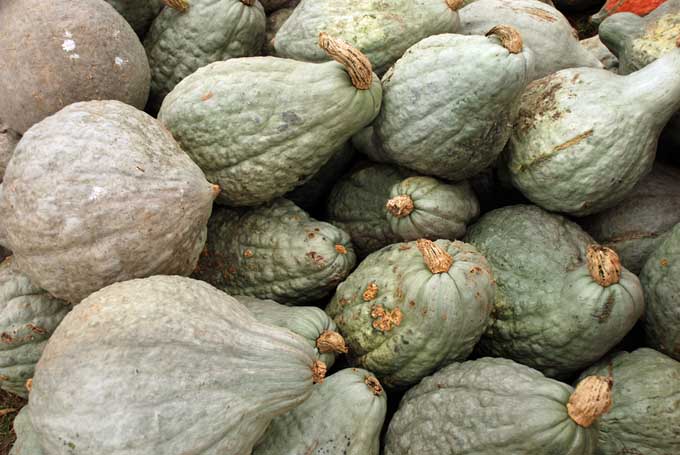
A hardy annual fruit, they’re planted in the warm months of spring and are allowed to ripen until mature seeds are formed and their rinds harden – as opposed to their summer cousins, like zucchini, that will have small, immature seeds and a soft, edible exocarp.
Winter squash are members of the Cucurbitaceae family, of the genus Cucurbita, which includes relatives such as melons, cucumbers, and summer squash, and are available in a broad range of varieties. Butternut, acorn, Hubbard, spaghetti, turban and kabocha are common types that will be found at most farmers markets and grocery stores.
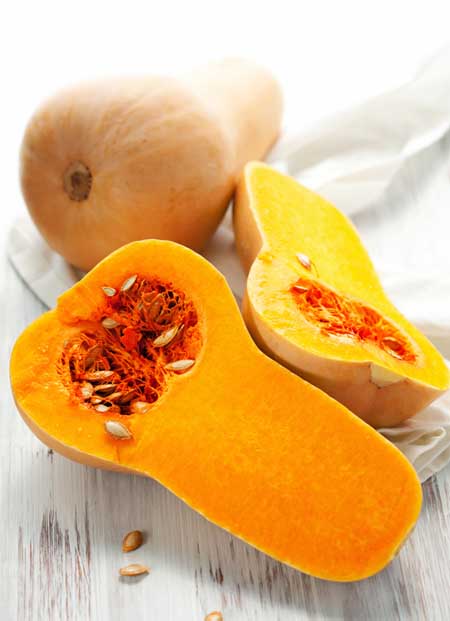
Local crops are usually available from the end of summer through winter, and with today’s global economy, numerous types are available year round in the larger grocery chains.
Another fruit that’s consumed as a vegetable, its origins lie in the regions of meso-America and the northern Andes, and both summer and winter squashes were introduced to Europe after colonization of the New World.
Even though seeds of the Cucurbitaceae family have been found in archeological sites such as ancient Egypt and the Roman Empire, they were from distant cousins of winter squash, in the gourd tribe. Some gourds are marginally edible, but their primary purpose was for making utensils and bowls, making their presence in the afterlife important.
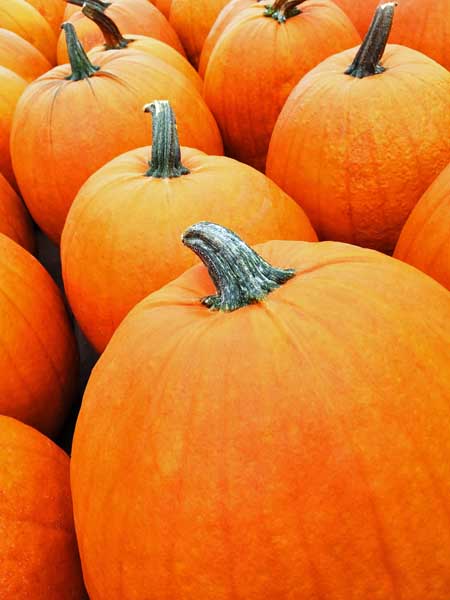
The most notable face of the hard-skinned squash clan is, of course, the pumpkin – star of both Halloween and Thanksgiving. But there are many other varieties available with a wide range of uses, all of which are full of flavor and nutrients.
Perfect for fall and winter meals, cucurbitas have a sweet flavor with a firm texture and great density, and all have the notable characteristic of a seed-filled inner chamber.
They also take well to a large spectrum of seasonings and are real crowd-pleasers in warming soups, stews, casseroles, tagines, lasagna, risotto, hummus, and even desserts.
They can be baked, steamed, grilled, sautéed, stuffed, pureed, or eaten raw. And, the seeds are delicious and nutritious as well; they can be cleaned, then dried in a food dehydrator, or lightly seasoned and roasted in the oven with other veggies.
With fantastic shape and color, they shine in autumn floral displays and are often prominently featured in Thanksgiving horns of plenty. Fun and easy to grow, they can be stacked and displayed outdoors in the garden or near your front door for attractive, seasonal arrangements.
Nutritional Value and Health Benefits
To a certain degree, we’ve come to think of leafy greens and color-intense fruits and veggies as our main sources of antioxidants. However, the many varieties of winter squash provide significant levels as well.
Cucurbitas have a superb phytonutrient content, elevating them above the realm of simply being a filling, starchy vegetable. Among the carotenoids found in winter squash are:
- Alpha-carotene
- Beta-carotene
- Beta-cryptoxanthin
- Lutein
- Zeaxanthin
And the polysaccharides found in the pectin of cell wall structures also provide key anti-inflammatory nutrients.
In terms of vitamins, winter squash is an outstanding source of vitamin A, which supports our immune system, and an excellent source of vitamin C, which scavenges potentially harmful free radicals. They also provide a good source of dietary fiber, vitamins B2 and B6, manganese, copper, potassium, pantothenic acid, omega-3 fatty acids, magnesium, and niacin.
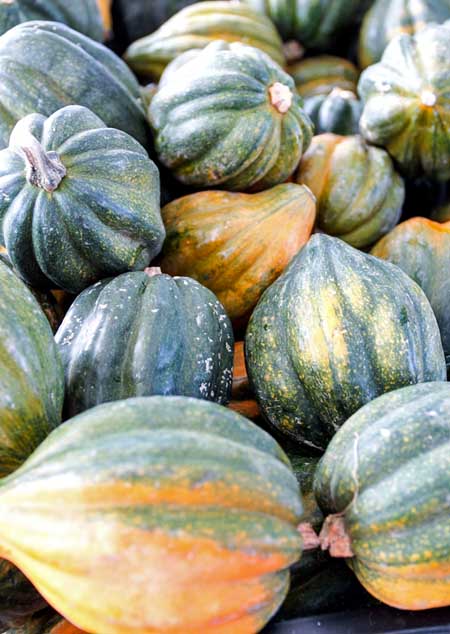
Another interesting point is that many of the carbohydrates found in winter squash actually come from the polysaccharides found in the cell walls.
And among these polysaccharides are pectins, which provide anti-inflammatory compounds – so, not all starches are created equal when it comes to carbs!
Increasingly, studies show that winter squash not only provides antioxidant and inflammation-fighting properties, it also shows promise in the field of regulating insulin levels as well.
Another area of promise is in the prevention of cardiovascular disease. The two important components of providing key antioxidants and anti-inflammatory benefits help to provide the nutrient support needed in lowering the risk of cardiovascular disease.
Initial work in this field suggests that the distinctive composition of cucurbitas may contain substances that partially block the formation of cholesterol, by inhibiting the production of a specific enzyme. Along with the components mentioned, winter squash is beginning to reveal itself as an important food to include in a heart-smart diet.
And, it’s this combination of antioxidant and anti-inflammatory compounds that also shows potential in terms of cancer prevention and treatment, in studies involving extracts from plants in the Cucurbita genus.
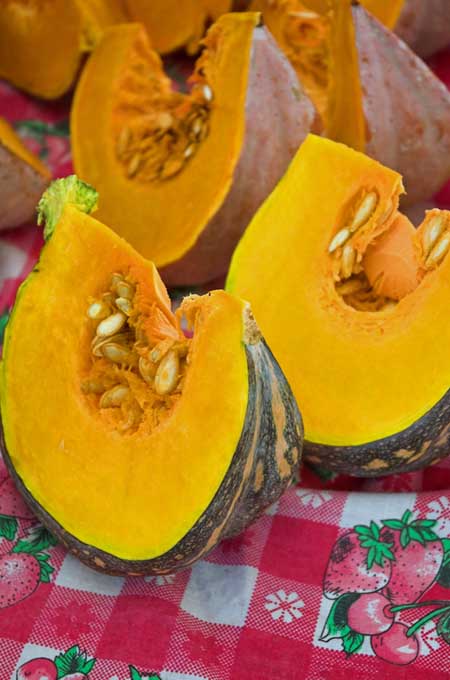
All winter squash are very low in saturated fats, cholesterol, and sodium, low in calories, and a good source of dietary fiber as well.
- Acorn squash has 56 calories per one cup serving, raw. For vitamins and minerals, it has the following amounts based on recommended daily values: 10% vitamin A, 11% vitamin B6, 11% folate and magnesium, 26% vitamin C, 13% thiamin, 14% potassium and 12% manganese.
- Butternut squash has 63 calories per one cup serving, raw. For daily values, it’s also a good source of vitamin A at a whopping 457%, 52% vitamin C , 13% vitamin B6, 13% vitamin E, 10% thiamin, 10% niacin and folate, 15% calcium and magnesium, 17% potassium, and 18% manganese.
- Hubbard squash has only 46 calories per one cup serving, raw. And it has important daily values as well: Vitamin A is at 32%, vitamin C is 21%, vitamin B6 is 9%, manganese is 10%, and potassium is 11%.
- Spaghetti squash has just 31 calories per one cup serving, raw. And although comparatively not as high in some daily values as other cucurbitas, it still provides significant nutrition. Vitamin C is at 4%, niacin and vitamin B6 both are 5%, pantothenic acid is 4%, and manganese is 6%.
Buying and Storing
Look for fruits that have a hard, intact rind with a slight sheen to its surface. Winter squash has a very dense texture, and these should feel heavy in the hand.
Avoid any fruit that has soft spots, and check the stem end to ensure that it’s firm. Don’t buy any items that are cracked, spongy, leaking, or showing exterior signs of mold or decay. If the stem is intact, it should be round and dry.
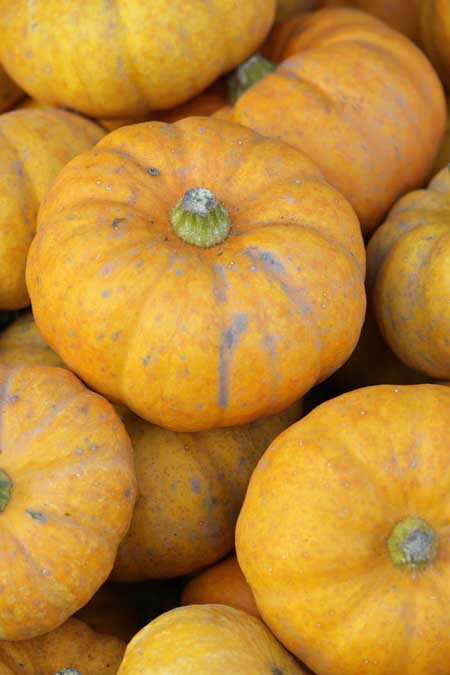
Beware of carrying them by the stem. The stem of a pumpkin or other heavy squash may snap off under the weight – it’s better to tote them with two hands.
A small winter squash will provide about 2 servings. Or, approximately one pound of squash will yield 4 one-half cup servings.
If you’re only using half, remove the seeds from the other half and seal in an airtight container in the fridge for 5-7 days. Unfortunately, raw squash doesn’t freeze very well. However, once cooked it will freeze nicely for 6-8 months.

To store, cucurbitas need to be dry – so don’t wash before putting them away. Spaghetti squash has the shortest shelf life, about two months. Most other varieties will last for three or four months, while Hubbards will keep well for as long as six months.
Cooking Winter Squash
In western culture, most varieties of winter squash are eaten cooked, though the flesh is a nice addition to salads when grated raw.
To serve on their own, all varieties bake well, and steaming is another good option. The hard shells are not eaten, but the seeds are perfectly edible, with their own high nutritional values. And different varieties can be treated in the same manner as pumpkin seeds.
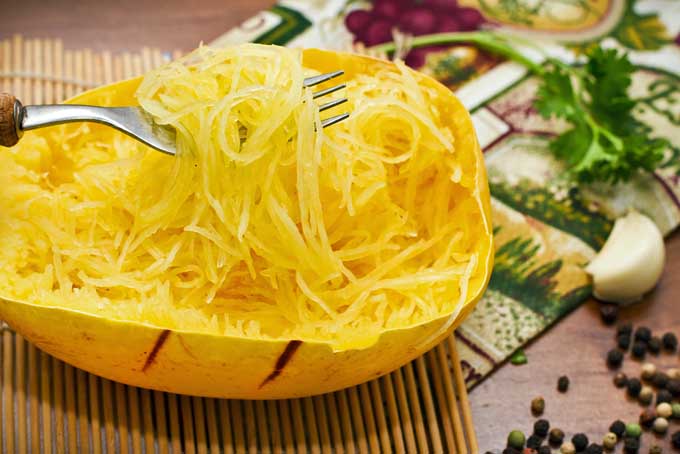
It’s also much easier to peel squash once it’s cooked. The flesh will easily pull away from the skin in chunks, or it can be scraped off with ease using a knife or spoon.
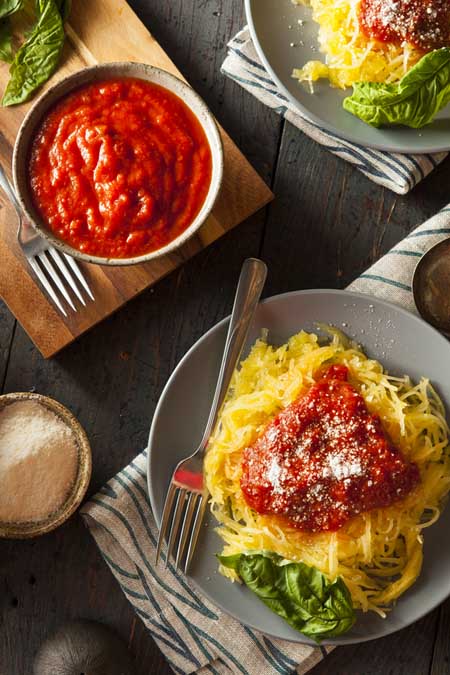
The majority of available varieties have a rich, sweet taste and firm flesh. And they can be easily substituted in recipes, one for the other – except for spaghetti squash.
- Butternut is exceptionally fine-grained, and is the ideal choice for pureeing when cooked. Also a natural in soups, sauces, and stews, as well as pasta dishes – even galettes!
- Acorn squash bakes up very nicely, like in our maple roasted acorn squash recipe, and is also a great vessel for sweet or spicy stuffing with quinoa, rice, or nuts- it makes a wonderful, edible bowl!
- Hubbards can grow very large and they’re often sold in pre-cut pieces. A good choice for baking into breads, muffins, scones, or pancakes, it also mashes nicely to make veggie patties and is a great addition to soups.
- Spaghetti squash has a different texture from the above, with long, slender and crunchy strands and a milder, sweet flavor. After cooking, the strands make a very satisfying substitute for pasta or rice. Mix it with ingredients like sun-dried tomatoes and caramelized onions. It’s also great served with your favorite pasta sauces, like tomato or pesto!
- Pumpkins have a huge range of uses – from pies to various soups to the moisture-retaining fruit element in baked goods. They are even included in some teas, coffees, and beer recipes! They can be baked, steamed, boiled, or stewed. These are bit rich, and may need to be toned down unless you are using them in a dessert.
Baking
To bake a whole squash, rinse well and pat dry with paper towels. Pierce the hard rind several times with a sharp knife to allow steam to escape while baking.
Place in a shallow baking dish and bake uncovered at 400°F. The time will vary according to the size of the item, but it will run in the range of 45 minutes for a small one, and up to 1 1/2 hours it it’s large.
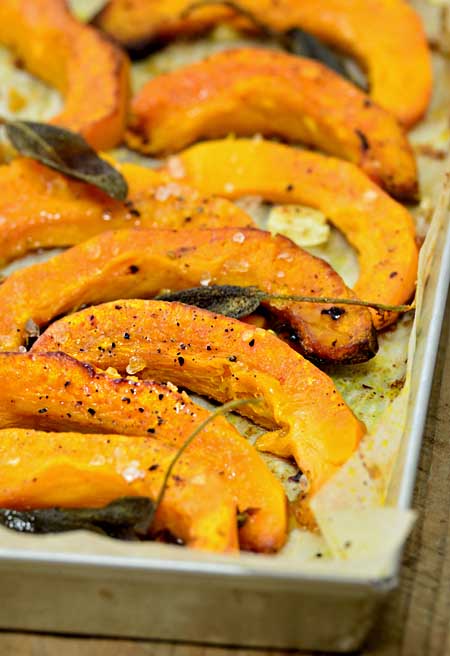
When done, the rind will give slightly under pressure. Remove from the oven and allow to cool for 10 minutes before handling. Cut in half, and scoop out the seeds and strings with a large spoon.
Cut into bite-sized pieces, or mash with a bit of butter and seasonings to taste. When completely cool, baked squash will freeze well for future use.
As a rule of thumb, one pound will yield four servings.
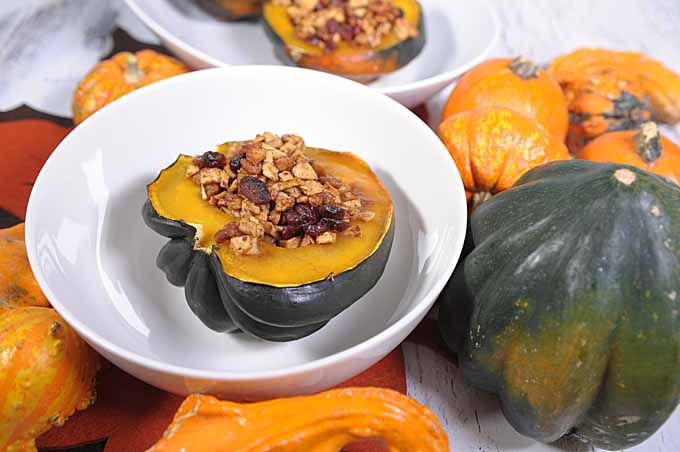
Lightly brush the cut and interior surfaces with oil, butter, or an herbed vinaigrette, and sprinkle lightly with cinnamon, nutmeg, or Parmesan cheese, if desired.
Place in a baking dish with a small drizzle of water (about 3 tablespooons) and bake uncovered at 400°F for 30-45 minutes (depending on size), or until tender.
Steaming
To steam, cut into 1” cubes and steam for 6 – 7 minutes, or until tender.
To roast seeds removed from winter squash, including pumpkin, scoop out the strings and seeds and place into a colander. Under cool running water, separate out the seeds and pat dry with paper towels, then place them in a single layer on a cookie sheet.
Leave them plain, or season lightly with sea salt and gently roast at 165°F for 15-20 minutes. Roasting for a short amount of time on low heat helps to minimize damage to the healthy oils contained in the seeds.
Recipes
And now, here are a few recipes for you to try the sensational tastes and outstanding health benefits of winter squash.
Hubbard Squash Veggie Patties
Enjoy the superb taste and nutrition of these healthy veggie burger patties.
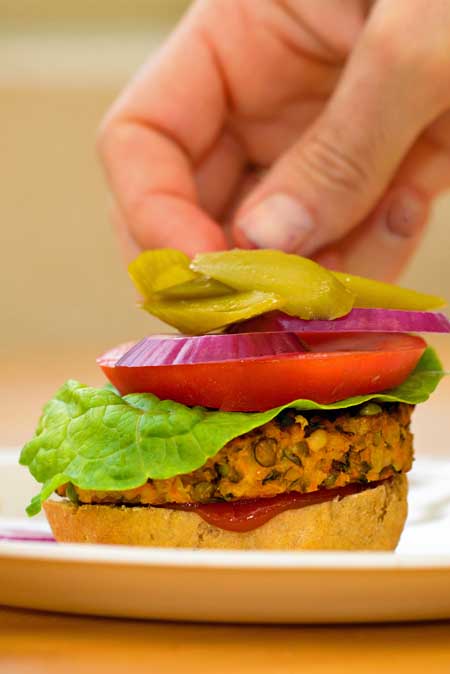
This recipe will make up to a dozen patties, so keep them for up to a week in the fridge, or you can freeze them for up to six months. These can be baked, fried, or enjoyed on the grill.
- 1 pound piece of Hubbard squash
- 1 1/2 cup gluten-free rolled oats
- 1/4 cup gluten-free flour
- 1 cup red onion diced
- 1 cup pistachios chopped coarsely
- 1 egg lightly beaten
- 1 teaspoon chili powder
- 1 teaspoon ground flax seed
- 1 tablespoon parsley minced
- sea salt
- fresh ground pepper
- Parchment paper
- Preheat oven to 400 F.
- Brush the squash with olive oil and place face down on a parchment-lined baking pan, and bake for 35 – 45 minutes, or until tender, depending on size.
- Test for doneness by poking with a fork. If you can push it easily into the flesh, it’s ready.
- Removed from oven and allow to cool enough to handle.
- Cut into chunks and remove the skin. Place in a colander over a bowl and allow excess moisture to drip away as it cools.
- In a large mixing bowl, mash the squash then add all the remaining ingredients and mix well.
- Form into patties using about 1/3 cup per patty, and place on a baking pan. Bake in a 350 F oven for 30 – 35 minutes, turning them over halfway.
- Remove from oven and serve hot.
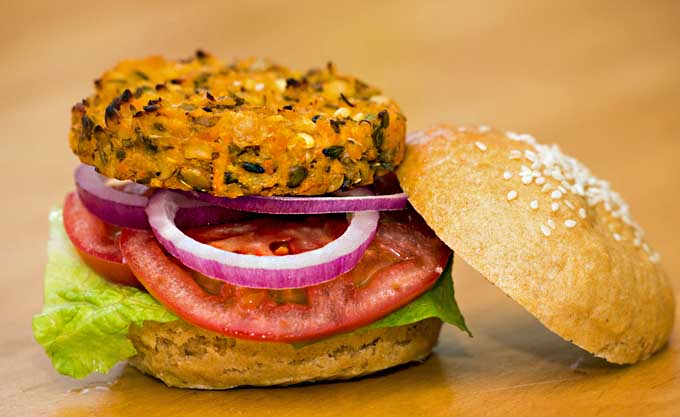
Pesto Spaghetti Squash
Spaghetti squash makes such a good alternative to pasta, it’s indispensable for anyone counting calories or carbs.
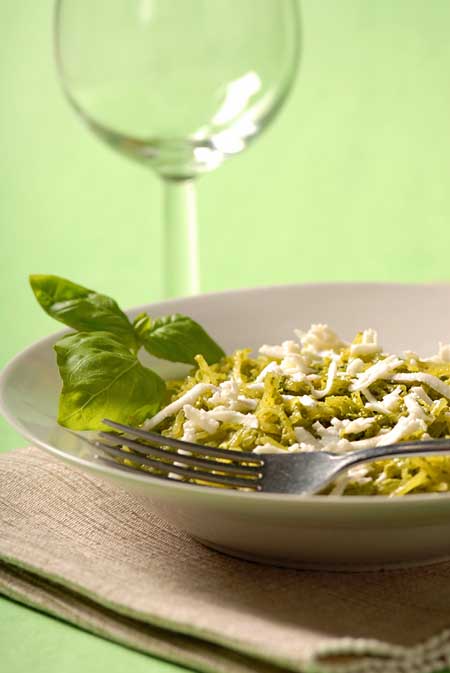
This spaghetti squash pesto can be served as an entree with a fresh salad and hearty artisan rolls, or as a side dish with meat, fish, or poultry. Also Check out Sarah’s alternative pesto sauce recipe as well as an authentic Italian variation.
- 1 medium spaghetti squash halved lengthwise, seeded
- 1/4 cup olive oil
- 2 small bulbs garlic
- 1/2 cup pine nuts
- 1/2 cup fresh parsley
- 1/2 cup fresh basil
- 1/4 cup grated Asiago cheese
- 1 1/2 teaspoons freshly squeezed lemon juice
- sea salt
- fresh ground pepper
- Parchment paper
- Preheat the oven to 375 F, and line a baking sheet with parchment paper.
- Brush the interior and cut sides of the squash lightly with olive oil, and season with salt and pepper. Place cut side down on a baking sheet.
- Slice off the tops of the garlic, then rub generously with olive oil and season with salt and pepper. Wrap in foil and place on the baking sheet with the squash. Bake until the squash is fork tender, about 35 to 40 minutes. When done, remove from oven and set aside to cool.
- To make the pesto, squeeze out the cloves of garlic and add them to a food processor along with pine nuts, parsley, basil and salt. Pulse until pulverized. While the motor’s running, slowly add the olive oil until mixed well. Add the lemon juice, and pulse a few more times until combined.
- Remove the skin from the squash, then shred with a fork and place into a serving bowl. Toss with the pesto, season with salt and pepper then sprinkle with the grated Asiago. Season with sprigs of parsley or a few basil leaves. Serve hot.
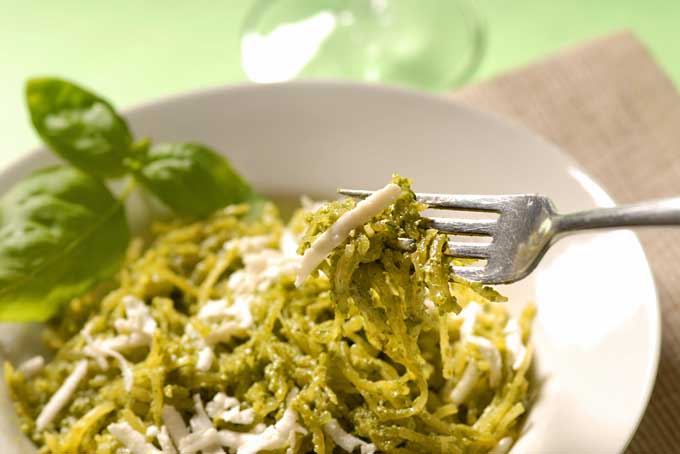
Butternut Squash and Leek Galette
This savory, free-form galette is nutritious and delicious, and just one taste will have you hooked.

What’s your favorite way to enjoy winter squash? Let us know in the comments!
Butternut Squash Galette photo by Felicia Lim, Stuffed Acorn Squash photo by Mike Quinn © Ask the Experts, LLC. ALL RIGHTS RESERVED. See our TOS for more details. Uncredited photos: Shutterstock.
About Lorna Kring
Recently retired as a costume specialist in the TV and film industry, Lorna now enjoys blogging on contemporary lifestyle themes. A bit daft about the garden, she’s particularly obsessed with organic tomatoes and herbs, and delights in breaking bread with family and friends.

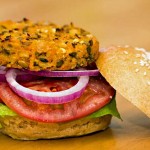
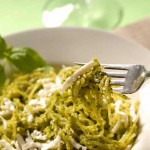



Man, these recipes make me regret living in a country that doesn’t do fall and winter! That galette looks absolutely divine. 🙁 I wonder if I can find butternut squash anywhere in the Philippines….
The galette is gorgeous chynnese. In the Philippines look for locally grown San Leonardo, Suprema and Nueva Viscaya varieties for your squash recipes.
Very thorough. I was especially interested to learn the nutrient contents of the different squashes. I figured they had plenty of carotenoids, vitamin A & C, fiber, and potassium but I had no idea about all the others. I was quite surprised that they had omega-3s and two of the B vitamins. I’ll have to start eating more. I love pumpkin and butternut, but only in savory dishes really. Not a fan of having my squashes prepared sweet. Maybe it’ll grow on me, but for now more savory recipes for me.
Isn’t it nice to have the options of sweet or savory with such a nutritious fruit. Glad you enjoyed the post.
The idea of pesto spaghetti squash is a really nice way eat it as sometimes I find it quite bland. I like butternut squash in soups, quiches and roasted. I’m not that adventurous because sometimes I over cook it and it’s too soft. As a vegetarian they are a great source of vitamins though and I do take advantage when they are in season
Like many veggies, they do benefit from some seasoning. And pesto is a nice alternative to the more typical tomato based sauce for spaghetti squash…. hope you enjoy it Bella!
I love fall vegetables, especially zucchini. One of my favorite ways to cook it is to cut it into spaghetti like stings and mix it with quinoa, mushrooms and broccoli. I try not to eat pasta and being able to substitute zucchini allows me to still enjoy the dishes I love but as a healthier version. I purchased the Veggiti and would recommend it to others!
Zucchini and spaghetti squash are great substitues for pasta Kimmy, and your dish sounds delish! Thanks for the Veggiti recommendation, they’re awesome for dishes like this.
Wow! I love most forms of winter squash and have enjoyed many recipes, but I have never considered using squash in veggie patties…and your galette is gorgeous!
It seems that the patties could be made in bulk and then frozen for a quick “teen” meal. Do you think I should alter the baking time in order to prepare tem for freezing?
Thanks for these new ideas…I am looking forward to these new recipes 🙂
The galette is pretty tasty Sixpete, and yes, I would reduce cooking time a bit for freezing. Hope you enjoy the recipes!